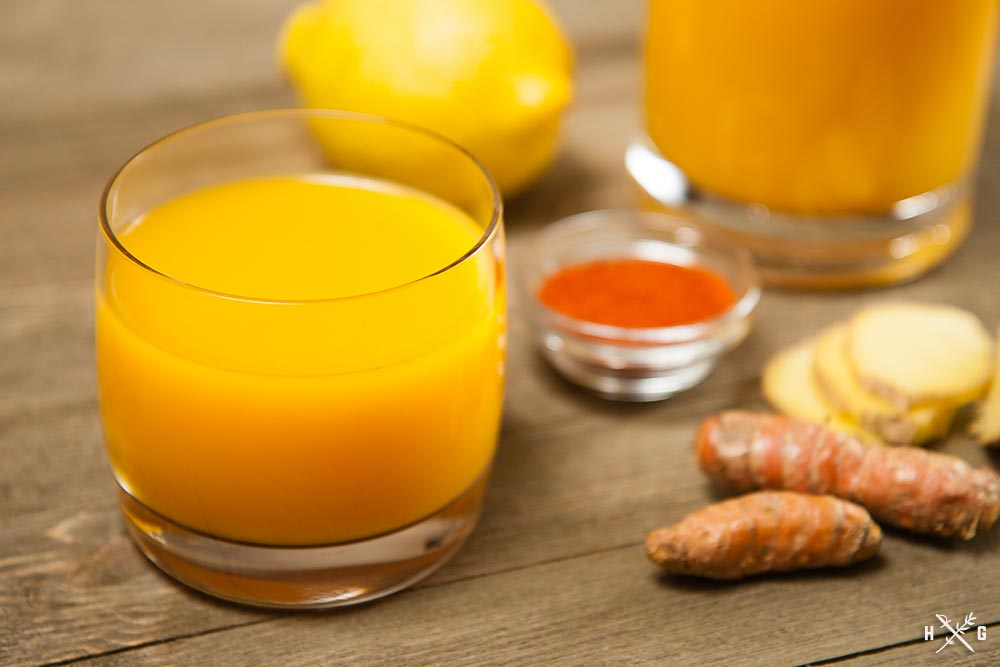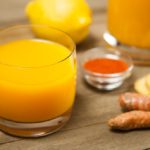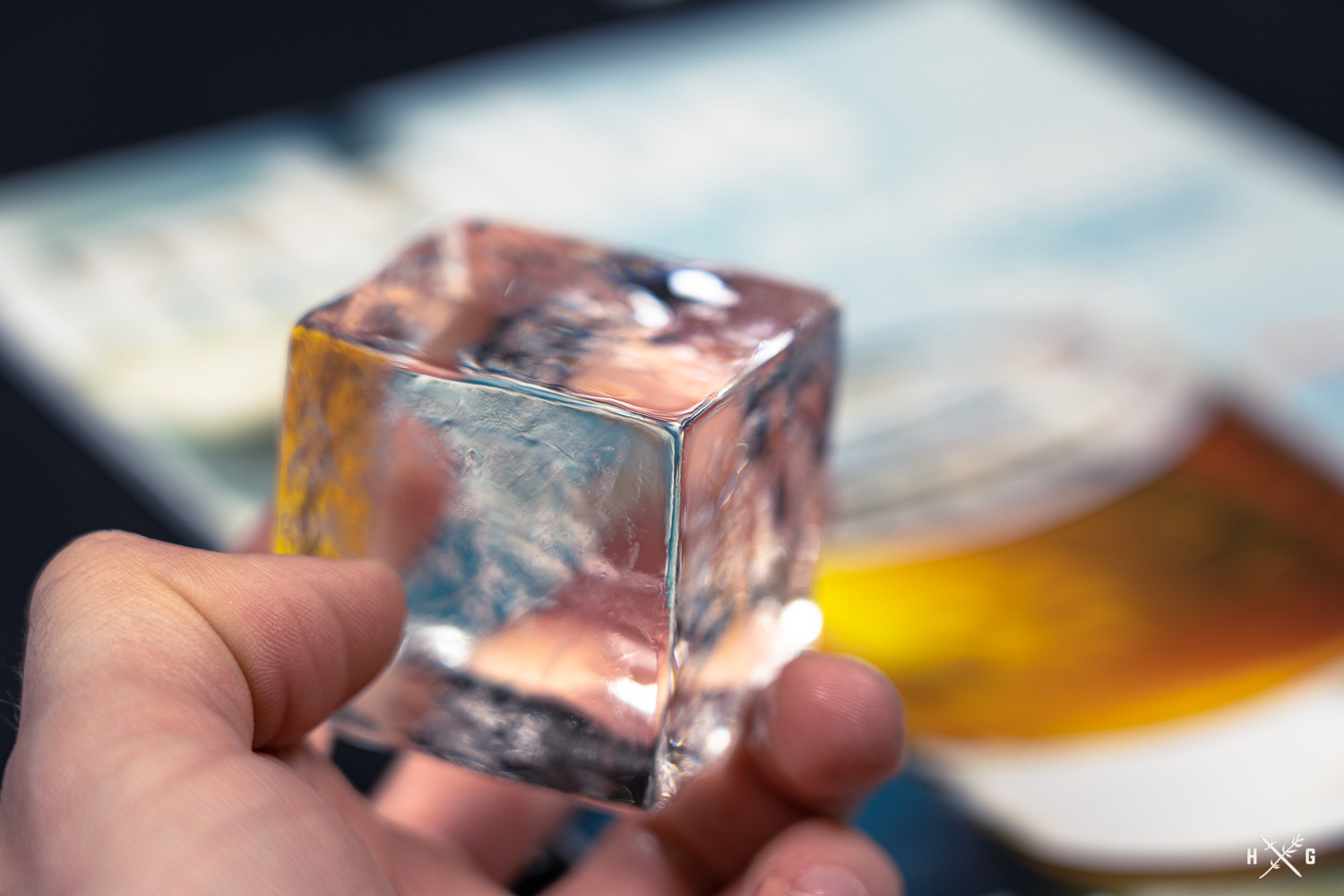Whether you’re looking for an everyday detox or something special to supplement a “dry January”, this “tea” is the perfect solution. For those observing a dry January, I’ve found that having something that tastes just as good as a cocktail, whiskey, etc. will help you maintain your willpower. Loose leaf tea is a great option for evenings, but I prefer to start my mornings with this ginger turmeric lemon tea. I enjoy it chilled, but I’ve seen similar recipes served hot – it’s truly personal preference. I’ve also seen it prepared by simmering the ingredients in hot water, but if you use a high-speed blender or juicer you’ll get more flavor and more of the actual ingredients in the resulting drink.
(If you’re looking for some simpler options that are more practical for everyday consumption, check out the resources at the end of this article which include some discounts for my readers.)
This drink’s benefits come primarily from the apple cider vinegar, ginger, and turmeric. While some may fall into the category of herbal remedies, others have passed medical scrutiny and have proven benefits. Here’s the rundown of the ingredients and the full recipe below. I’ve also include links to some other detox products as well as the bottles I use at home for storing this an other drinks I make.
Apple Cider Vinegar
Apple cider vinegar is a natural remedy that has found its way back into popularity. Studies show that apple cider vinegar may be helpful in aiding weight loss and maintaining blood sugar. For the full benefits, consume raw, unfiltered, unpasteurized vinegar which will contain the “mother”. (I prefer Bragg brand.) The mother is the sediment-like mass that contains probiotics that promote healthy gut bacteria and can support immune system function. When consuming apple cider vinegar, make sure to dilute it. Don’t drink more than 1-2 tablespoons in a glass of water up to two times a day. The acetic acid can erode tooth enamel and the esophagus.
Ginger
Ginger root has been used for thousands of years in Asian cooking as well as a remedy to treat upset stomach, nausea, and aid digestion. Ginger root is a rhizome, meaning it’s an underground stem. The active components in ginger are thought to be the gingerols and shogaols. Studies show that ginger can reduce certain symptoms of motion sickness such as vomiting and cold sweats, but not reduce the feeling of nausea. Ginger has also been used in traditional medicine to reduce inflammation, but has been shown to be of the same level of effectiveness as over the counter pain relievers and placebos.
Cayenne
The active component in cayenne (and other) peppers is capsaicin. Capsaicin is a topical analgesic often used in ointment form to treat joint and muscle pain and nerve pain related to skin conditions. Cayenne pepper may also reduce appetite, contributing to weight loss. Preliminary studies suggest capsaicin may be useful in treating circulatory problems and possess anti-tumor properties.
Turmeric
Turmeric is another rhizome, and is related to ginger. The active substance in turmeric, curcumin, may be one of the most promising herbal remedies, but is also the one with the most conflicting research. Curcumin is an antioxidant, which means it can clear the body of free radicals. Preliminary studies suggest that turmeric may help treat or prevent certain types of cancers. Other studies suggest it may also be useful in treating atherosclerosis, which can lead to heart attack or stroke. Turmeric can also be taken in capsule form, which I do daily.
Honey
Sadly, the oft-touted benefits of consuming local raw honey have little evidence to back them. Windborne pollen is not the same pollen that is spread by insects and contained in honey. Aside from the old honey and lemon cough remedy, many of these benefits may be folklore. However, this doesn’t change the fact that it’s an excellent sweetener.
P.S. – None of the above is medical advice. Simply believing the alleged health statements doesn’t mean they are all accurate, proven, or agreed upon. The best choice is moderation. If your relationship with alcohol is worrisome or even in a gray area, talk to a healthcare professional or even a friend. Accountability can go a long way.
Furthermore, check with a doctor before consuming any of these in large quantities. Some may interact with specific medications, or should not be consumed by people with certain medical conditions.
Ginger Turmeric Lemon Detox Tea
Ingredients
- 2½ cups water
- ½ cup apple cider vinegar organic, unpasteurized, unfiltered
- 1 lemon
- 45 grams ginger root
- 30 grams turmeric root
- 4 tablespoons honey
- ½ teaspoon cayenne pepper
- 3 turns black pepper
- 1 pinch salt
Instructions
- Peel ginger and turmeric root. (Peeling with a spoon is the simplest method and also be aware – turmeric will STAIN EVERYTHING, including your hands. Wear gloves, cover cutting boards and any surfaces.)
- Quarter the lemon and chop the ginger root and turmeric into smaller pieces. (if using a blender)
- Combine ingredients in a heavy duty blender, and blend until the contents are as pureed/juiced as possible.
- Double strain through a cheesecloth and a fine wire mesh sieve.
- Bottle and store refrigerated 2-3 weeks.
Notes
[divider type="double-dotted" color="gray"]If you want a simpler detox option, I suggest Traditional Medicinals’ EveryDay Detox Tea. It’s a great option to have at hand anyways.
A few other options I have tried include:
- DOSE Liver Cleanse Liquid Supplement – 15% Off for The Humble Garnish Readers
- Biocol Labs Detox Ampules
-
Bormioli Rocco 33.75 ounce Glass Bottles (4-pack) – I love these bottles! These larger ones are great, but I also use the 8.5 ounce ones often.
References:
WebMD – Apple Cider Vinegar and Health





How much do you drink a day? I made the recipe but unsure how much I should be consuming each day, also when is the best time to drink it? Before breakfast?
Hi Ashley! I prefer to drink it in the morning, and I’ll drink about 4-6 ounces. You can certainly drink it any time though. ????
Cheers!
I’m confused about the amount of Apple cider vinegar …in the beginning of this it states that u should not have more then 1 to 2 tablespoons a day…then in the recipe it says 1/2 cup in the recipe…so if u make this recipe how much do u consume in a day?
Hi, Sue.
Great question. Since it’s half a cup of ACV, that converts to 8 tablespoons contained in the entire 750ml bottle.
If we convert the 750ml bottle to ounces we’re at just over 25 ounces, and those 8 tablespoons of ACV equals 4 of those ounces.
Based on this, around 6 ounces would keep you under 2 tablespoons of ACV a day. The main concern with the ACV is that it’s acidic. You can also adjust the amount of ACV in the recipe to suit your needs.
Hope that helps to clarify. Thanks for reading!
– Andrew
Just made a batch. I put it in 2 oz Mason jars. I figures I would take one In The AM and one in the PM. I made it accordingly to the 750ml. So 4 oz a day. So this will last about 5 days. Will possibly ad more ACV next batch.
I added a little cinnamon also to mine.?
Thanks
Awesome! Glad you enjoyed it!
If I wanted to add Milk Thistle to the 750ml batch, how much would I add?
? That you
Donna
Hi, Donna! I’m no expert on herbal supplements like milk thistle, but I’m sure there is a lot of info to be found online. A quick search and I see that some sites recommend you keep it under 420mg/day. https://www.drugs.com/npp/milk-thistle.html
Thank you
Is this the same as. “shots” or is it best to drink in larger amounts
I generally find that the shots are more concentrated. You could add less water to make it more concentrated.
For this recipe, I generally make a large batch then have a small glass.